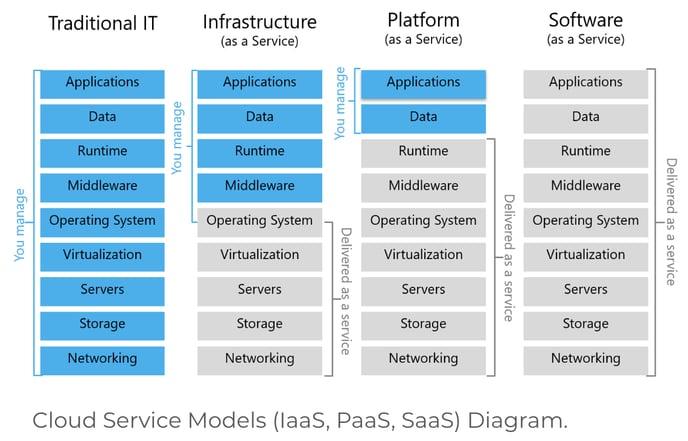Cloud-Native, Iaas, Paas und SaaS
Below is a breakdown of the different ways companies are monetizing cloud computing to offer different types of online services to customers.
- Infrastructure as a Service (IaaS)
The infrastructure represents the bottom layer in cloud computing. IaaS describes a business model that does not offer a complete solution including hardware and software, but only the hardware required to implement certain applications. This is located in data centers and is also maintained there. Cloud users are given access to virtualized components for data processing, data transport and data storage and can therefore use and install any application programs and operating systems. IT infrastructure and maintenance are rented.
- Plattform as a Service (PaaS)
The platform represents the middle layer. Here, it is not so much the IT administrator who is called upon, but the software developer. Platform as a Service is a service that enables developers to develop and run their own programs on the infrastructure offered by means of interfaces. For this purpose, the PaaS provider makes development environments available in the form of frameworks. In doing so, it specifies the programming languages and interfaces to be used, as well as data storage, networks and data processing systems. However, the developer has no administrative or control access to the infrastructure used to provide the service. He can only control the programs and data he has brought in himself.
- Software as a Service (SaaS)
Applications represent the final /top layer and build logically on all previous layers. Software as a Service is a business model in which the software application is no longer sold to the customer, but is provided as a service in return for payment.
Consequently, software as well as IT infrastructure are operated by an external service provider. In most cases, all that is needed to run the software is an Internet-enabled device and an Internet browser. This makes it possible to use inexpensive hardware in the company, while at the same time benefiting from the full computing power and storage capacity of a data center. Software is not licensed and installed on your own hardware, but only "rented" as a service and can be used anywhere with any Internet browser.
Haven't most of us seen a version of the chart comparing cloud computing service models (IaaS, PaaS, SaaS) and on-premises environments sometime in the last few years? You know, the one that uses a visualization of four software (layer cake) stacks to describe the differences between infrastructure, platform and software "-as-a-service" models as described in The NIST Definition of Cloud Computing?

Source: https://dachou.github.io/2018/09/28/cloud-service-models.html
Progress in this industry is moving fast. Conversations soon shifted from explaining and justifying PaaS to primarily deeper discussions and engagements about real development projects. The lines between IaaS and PaaS began to blur even before Azure made virtual machines available in 2012. It became more and more about aggregating capabilities into cloud projects, regardless of what “cloud model” was used by a particular implementation (e.g., API, component, feature, service, etc.). Application projects consisted of services and features based on both IaaS and PaaS options. It was no longer IaaS or PaaS; it was IaaS AND PaaS AND SaaS. In addition, the maturity around hybrid cloud approaches was increasing, blurring even the lines with on-premises environments.
Comments